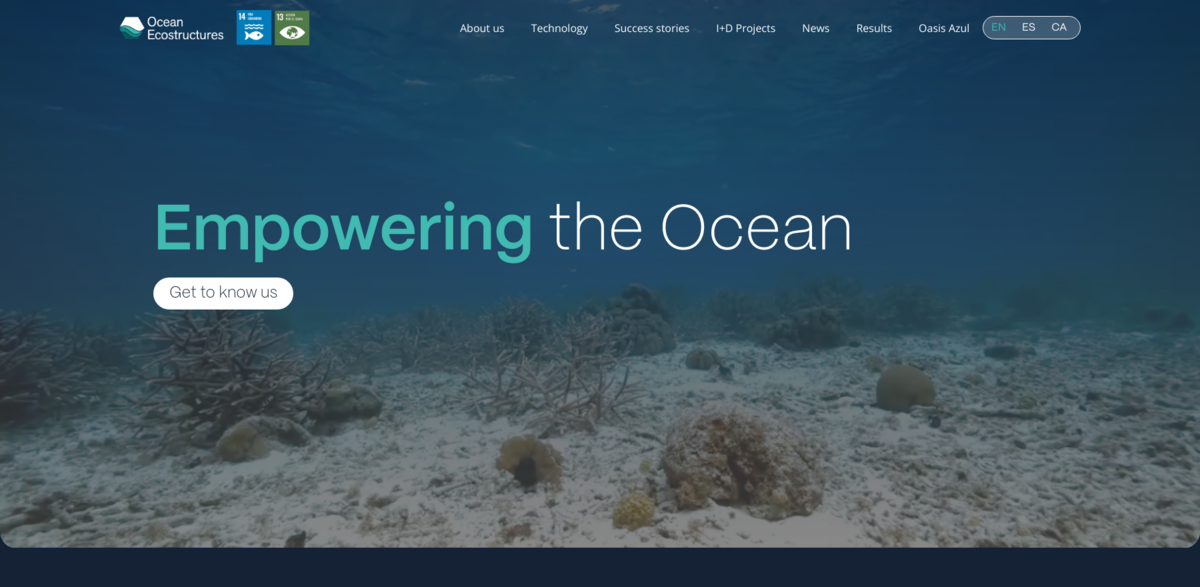What is Ocean Ecostructures?
Ocean Ecostructures is a Bluetech startup that’s all about transforming marine infrastructures into vibrant blue oases. They fight against the loss of marine biodiversity using multi-technological solutions designed to restore, regenerate, and protect the ocean. Their approach is unique — combining biomimetic technology with robotics and Artificial Intelligence to create a revolutionary Bio Boosting System®. This system uses carbonate calcium micro-reefs to replicate natural coral ecosystems, offering up to six times the regenerative potential compared to traditional artificial reefs. Plus, all the data collected is stored in a digital platform called iOceans, making it easy for customers to track impact and meet ESG, compliance, and sustainability goals.
Main Benefits of the Technology
Ocean Ecostructures’ solutions bring some impressive benefits to the table:
- Multiplying biodiversity up to six times compared to conventional materials
- Revitalizing up to 20,000 marine spaces by 2030
- Combining regeneration technology with robotics for real-time monitoring
- Using Artificial Intelligence for advanced data processing and analysis
- Aligning with global sustainability standards like CSRD and TNFD
- Turning gray maritime infrastructures into nature-positive blue oases
Innovative Projects Driving Change
Several cutting-edge projects showcase the company’s commitment to ocean regeneration. The OASIS project integrates regenerative biodiversity technology with sensorized Unmanned Surface Vehicles (USVs) and Artificial Intelligence to create virtual sensors and digital twins — a multi-tech approach that’s pretty next-level. Then there’s NEXTFLOAT, which focuses on optimizing renewable energy production through an innovative floating platform and efficient connection systems, making floating offshore wind more competitive and cost-effective. And don’t forget EFFECTIVE, a project dedicated to developing an ecosystem-based management approach to protect and restore the Mediterranean Sea’s natural capital.
How It All Started
The journey began in 2021 in Barcelona, when Ignasi Ferrer, Mireia de Mas, and Anna Lloveras combined their expertise in oceanography, biology, operations, and business management. Their goal? To develop a regenerative and scalable solution specifically designed for marine infrastructures. Since then, the company has grown, driven by a passion for restoring marine ecosystems on a large scale and making human activity in the oceans more ocean-friendly.
Technology Behind the Scenes
At the heart of Ocean Ecostructures’ work is the Bio Boosting System®, a pioneering biomimetic approach that uses carbonate calcium micro-reefs to mimic natural coral ecosystems. This isn’t your typical artificial reef — it’s a game-changer that offers significantly higher regenerative potential. The system is supported by robotics that monitor results in real time and Artificial Intelligence that processes the data. All this information is accessible through the iOceans digital platform, allowing stakeholders to track progress, fulfill ESG requirements, and engage socially with their sustainability efforts.
Project Impact and Sustainable Development Goals (SDGs)
- SDG 14: Life Below Water – Protecting and restoring marine ecosystems
- SDG 13: Climate Action – Supporting renewable energy and carbon offsetting
- SDG 9: Industry, Innovation, and Infrastructure – Developing cutting-edge Bluetech solutions
- SDG 17: Partnerships for the Goals – Collaborating with global organizations and partners
- SDG 15: Life on Land – Indirectly supporting coastal and marine biodiversity
Recognitions and Partnerships
The transformative potential of Ocean Ecostructures’ solutions hasn’t gone unnoticed. Major global organizations have recognized their successes, validating the impact and innovation behind their work. Their strong network of partners plays a crucial role in driving continuous improvement and innovation, ensuring that their products stay at the forefront of marine regeneration technology. Together, they’re pushing the boundaries of what’s possible in ocean restoration and sustainability.





















